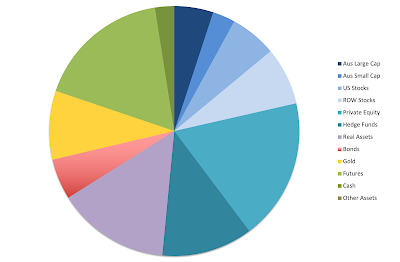In October, the Australian Dollar rose very slightly from USD 0.6542 to USD 0.6550 meaning that USD investment returns are slightly better than AUD investment returns. Stock markets were flat or fell with a lot of intramonth volatility (total returns including dividends):
US Dollar Indices
MSCI World Index (gross): 0.02%
S&P 500: 0.25%
HFRI Hedge Fund Index: 0.01% (forecast)
Australian Dollar Benchmarks
ASX 200: -2.51%
Target Portfolio: -0.34% (forecast - depends on HFRI result)
Australian 60/40 benchmark: -0.42%
We lost 1.93% in Australian Dollar terms or 1.88% in US Dollar terms. So the only benchmark we beat was the ASX 200. Our performance was hit by the crash in the price of 3i (see below). After underperforming last month, the SMSF returned 0.16% beating Unisuper (-1.06%) and PSS(AP) (-0.61%).
Here is a report on the performance of investments by asset class:
Things that worked well this month:
- Two investments gained more than AUD 10k: Gold (AUD 38k), Berkshire Hathaway (11k).
What really didn't work:
- Four investments lost more than AUD 10k: 3i (-), bitcoin (-28k), Defi Technologies (-20k), and Dash/IPS (-17k). 3i crashed after saying sales growth recently was soft in Action's French market. A more than 25% fall in the share price seems to be an irrational response. The actual earnings report was great. I bought more, but as usual was too early. I got out of all crypto investments (see below). IPS didn't do as well as hoped and so the "earn out" component of the takeover was less than expected.
Here are the investment performance statistics for the last five years:
The top three lines give our performance in USD and AUD terms, while the last three lines give the same statistics for four benchmarks. The middle block gives our performance relative to the indices.Our alpha relative to the ASX200 is 2.9% with a beta of only 0.51. We have much lower volatility, resulting in a information ratio of 1.30 vs. 0.99. We capture much less of the downside moves than the upside moves in the market. We also have very good performance relative to the Vanguard 60/40 portfolio with similar volatility but 3.5% p.a. more return. We captured 104% of the upside of this portfolio but only 69% of the downside. But as we optimize for Australian Dollar performance, our USD statistics are much worse. We do beat the HFRI hedge fund index in terms of return, but at the expense of far higher volatility. Our USD volatility is at least less than that of the MSCI index, but our return is almost five percentage points lower!
We moved a bit away our target allocation due to investments and investment performance. Our actual allocation currently looks like this:
About 65% of our portfolio is in what are often considered to be alternative assets: real estate, art, hedge funds, private equity, gold, and futures. A lot of these are listed investments or investments with daily liquidity, so our portfolio is not as illiquid as you might think.
We receive employer superannuation contributions every two weeks. We make monthly concessional contributions to Moominmama's superannuation to reach the annual cap on contributions. There is one remaining USD 10k contribution to make to the Unpopular Ventures Rolling Fund and there will be capital calls from Aura Venture Fund II and III. I am now receiving TTR (soon to be retirement) pension payments from both Unisuper and our SMSF and contributing more than the total of these back to my superannuation accounts for the remainder of this financial year.
I was quite busy making the following additional moves this month:
- I bought 700 shares of 3i (III.L) after the price crashed. I still believe in the company.
- I sold our entire bitcoin position across three accounts. This was just over one bitcoin's worth.
- I also sold our ether position.
- I sold our Defi Technologies (DEFT) position (15k shares).
- I bought 36k WAM Capital (WAM.AX) shares.
- I bought 5k Regal Partners (RPL.AX) shares.
- I sold 1k WCM Global Quality (WCMQ.AX) shares.
- I sold 500 Pershing Square Holdings (PSH.L) shares.
- I bought 30k Cadence Opportunities (CDO.AX) shares.
- I bought 1k Putnam BDC (PBDC) shares.
- I sold 750 PMGOLD.AX gold ETF shares.
- I made a non-concessional contribution of AUD 40k to Unisuper.
- I bought 2k Hearts and Minds (HM1.AX) shares.
On the whole it is a shift from speculative investments to income investments, though the extra 3i shares are speculative. The last day of the month was my retirement date. This month's net worth (not including our house) together with the redundancy payment I should get this week constitutes our "retirement number". It should be approximately AUD 6.8 million. Using the 4% rule means we could spend AUD 272k per annum. Our spending is a lot below that. Total net worth at the end of November is at AUD 7.78 million.










































